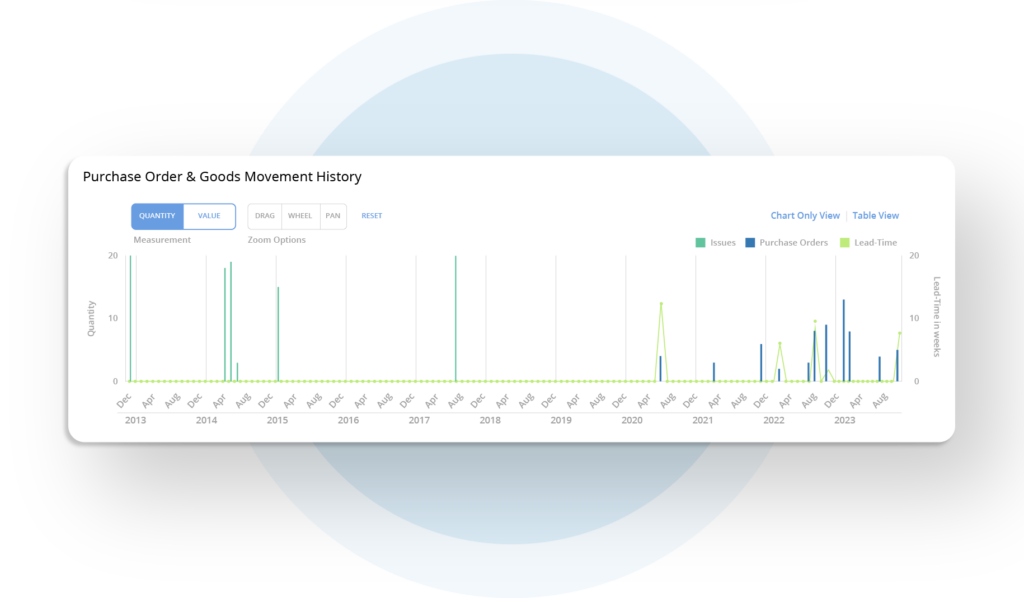MRO Inventory Optimization
Right-Size Your MRO Inventory To Balance Working Capital & Risk
Challenges of Optimizing MRO Inventory
Managing MRO inventory is a complex and high-stakes challenge, and without the right tools in place it’s often hindered by reliance on guesswork. Setting accurate inventory levels for each part is a scientific process that factors in demand variability, lead time, criticality, and other complex metrics. But when you’re managing 100,000+ unique parts with limited time and resources, guesswork becomes the default approach.
Excess inventory and carrying costs
Many organizations keep excess inventory as an insurance policy against stockouts, but this approach ties up capital that could be used elsewhere.
Stockouts & Downtime
Risk
Unplanned equipment downtime due to unavailable parts can severely impact productivity, increase operational costs, and delay critical maintenance.
Inaccurate Forecasting Based on Guesswork
Managing thousands of unique parts often leads to reliance on guesswork estimates and past usage patterns, which can be error-prone.
An Always-On Approach to MRO Inventory Optimization
Manage your MRO and spare parts inventory without the guesswork. Our AI-driven MRO Inventory Optimization eliminates excess materials to save money and prevents stockouts to reduce unplanned downtime—removing data cleansing prerequisites.


Our AI Platform
Ingests and understands the context of your material data
from your systems of record, such as work order and procurement history, supply constraints, etc.
Identifies ongoing savings and risk opportunities
by automating complex data analysis to enable data-backed decisions and eliminate the time and guesswork from MRO.
Provides real-time policy updates
continuously analyzing real-time data to dynamically recommend stocking policies adjustments, considering business and market changes.
What's In ItFor You
Strike the perfect balance of working capital and risk: ensuring you have what you need without overstocking.
Lower Excess Inventory, Carrying Costs, and Capital
Overcome costly data challenges and find the perfect balance between having necessary parts available while avoiding costs of carrying excess inventory as an insurance policy.
Reduce Stockouts and Downtime Risks
Gain accurate inventory visibility to build trust that critical parts are available when needed, minimizing downtime disruptions and maintaining operational continuity.
Save Time & Improve Decisions
Make data-backed, strategic decisions to align procurement with demand, respond proactively to operational changes, and improve forecast accuracy that considers parts criticality, usage variability, and lead times.
Transform Your MRO Supply Chain
Reducing unnecessary spending, and ensuring material availability for the perfect balance of working capital and risk.
Continuous, Automated, Always-On AI
Verusen’s AI platform uses advanced natural language processing (NLP) to tackle MRO inventory challenges. With over 20 million SKUs ingested, it enables immediate optimization without the need for data cleansing or third-party assistance, utilizing your existing data as-is.
Frequently AskedQuestions
Most Verusen customers are fully operational within 45 days from the time we receive the initial data transfer.
Typically, customer resources dedicate just 2-4 hours per week during the onboarding process. This is significantly less than what is required with traditional SaaS solutions, which often demand upwards of 30 hours from IT teams.
Verusen integrates seamlessly with a wide range of ERP, EAM, and P2P systems, using our comprehensive suite of certified, optional connectors to provide the insights and results you need.
Verusen doesn’t use seat licenses, so you get unlimited access for all relevant team members. Admins, chosen by you, can easily grant access to anyone in your organization who needs it.
